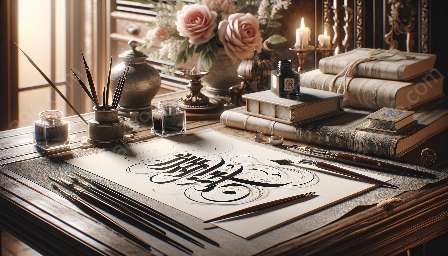Calligraphy is a beautiful art form that has been shaped by diverse cultural influences throughout history. Understanding these influences and incorporating them into teaching practices for kids can enrich their learning experience and broaden their appreciation of the art of calligraphy.
Cultural Influences on Calligraphy
Calligraphy has been an integral part of various cultures for centuries, with each culture contributing unique styles, techniques, and philosophies to the art form. Some of the significant cross-cultural influences on calligraphy include:
- Chinese Calligraphy: Chinese calligraphy, known as 'shufa,' has a rich history dating back thousands of years. It focuses on expressing emotions and the flow of energy through brushstrokes, incorporating the principles of Taoism and Confucianism.
- Arabic Calligraphy: Arabic calligraphy, also known as 'khatt,' is an essential art form in the Islamic world. It is characterized by intricate designs and geometric patterns, often used to represent verses from the Quran or other Islamic texts.
- Japanese Calligraphy: Japanese calligraphy, or 'shodo,' embodies the aesthetic principles of simplicity, asymmetry, and grace. It is heavily influenced by Zen Buddhism and emphasizes the harmony between body and mind during the act of writing.
- Western Calligraphy: Western calligraphy encompasses various styles, from the ornate letterforms of medieval manuscripts to modern typographic designs. It has been shaped by cultural movements, such as the Renaissance and Art Nouveau, and continues to evolve with contemporary artists.
Incorporating Cross-Cultural Influences into Teaching Practices for Kids
Teaching calligraphy to kids provides an opportunity to introduce them to diverse cultural traditions and artistic expressions. By incorporating cross-cultural influences into teaching practices, educators can create a more immersive and meaningful learning experience for young aspiring calligraphers.
Exploring Cultural Traditions:
Introducing kids to the history and significance of calligraphy in different cultures can spark their curiosity and appreciation for diversity. Educators can showcase examples of Chinese, Arabic, Japanese, and Western calligraphy, highlighting the unique characteristics and artistic philosophies of each tradition.
Hands-On Workshops:
Organizing hands-on workshops that allow kids to experiment with various calligraphy tools and techniques from different cultures can foster creativity and cross-cultural understanding. Children can learn to use Chinese ink brushes, Arabic calligraphy pens, Japanese sumi ink, and Western calligraphy nibs, gaining insight into the diverse tools and materials used across different traditions.
Multicultural Interpretation:
Encouraging kids to create their own calligraphy pieces inspired by different cultural influences can promote artistic expression and cross-cultural awareness. For example, students can explore the fluidity of Chinese brushstrokes, the intricate patterns of Arabic calligraphy, the minimalist elegance of Japanese characters, and the decorative elements of Western letterforms.
Interactive Learning Activities:
Engaging kids in interactive learning activities, such as tracing historical calligraphy scripts, deciphering symbolic meanings, and practicing meditative writing techniques, can cultivate a deeper understanding of cross-cultural influences on calligraphy. Educators can incorporate storytelling, games, and collaborative projects to make the learning experience both educational and enjoyable.
Conclusion
Integrating cross-cultural influences into teaching practices for kids can enhance their appreciation of calligraphy as a global art form. By exploring the diverse traditions and techniques of Chinese, Arabic, Japanese, and Western calligraphy, young learners can develop a deeper understanding of cultural diversity and artistic expression. Through hands-on experiences and interactive learning activities, educators can nurture a new generation of calligraphers who embrace the beauty and richness of cross-cultural influences in calligraphy.

